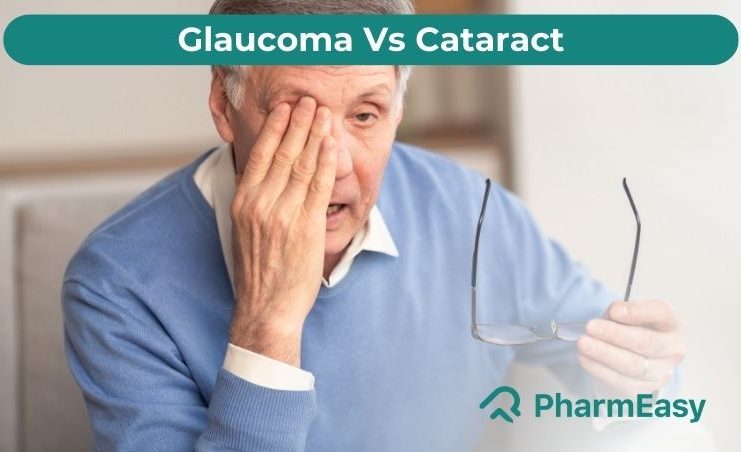Difference between Glaucoma vs Cataract
By Manav Sodhi +2 more

Download PharmEasy App




Register to Avail the Offer
Send OTPBy continuing, you agree with our Privacy Policy and Terms and Conditions
By Manav Sodhi +2 more
Table of Contents
It is a disease of the eye in which your optic nerve is damaged. It usually happens when fluid (aqueous humour) builds up in the front part of your eye and increases the pressure in your eye. The condition is a leading cause of blindness for people aged above 60 years.

Cataract is a medical condition of the eye in which the normal eye lens becomes cloudy as the proteins and fibres in the lens begin to break down. It appears like a white spot which slowly keeps growing in size, causing foggy and blurry vision. It may even lead to impaired vision and requires surgery.
| Different Factors | Glaucoma | Cataract |
| Causes | > Optic nerve damage > InjurySevere eye infection > Blocked blood vessels inside your eye > Any inflammatory conditions of the eye > Eye surgery to correct any other eye condition. | > Ageing >Injury > Some inherited genetic disorders > Past eye surgery or medical conditions such as diabetes or high blood pressure. > Long-term use of steroid medications. > Smoking > Excessive exposure to sunlight > Radiation treatment to your upper body. |
| Symptoms | > A patchy blind spot in your eye causing difficulty seeing things > Severe headache and eye pain > Nausea or vomiting > Blurred vision > Halos or coloured rings around lights > Eye redness > Increased blinking or tears without crying (infants) > Nearsightedness (myopia) is a common vision condition in which objects farther away look blurry. > Gradual loss of side vision | > Clouded, blurred or dim vision > Increasing difficulty with vision at night > Sensitivity to light and glare > Need for brighter light for reading and other activities > Halos around lights > Frequent changes in eyeglass or contact lens prescription > Fading or yellowing of colours > Double vision in a single eye |
| Diagnosis | > Tonometry, to measure intraocular pressure > Testing for optic nerve damage with a dilated eye examination and imaging tests > Visual field test > Pachymetry to measure corneal thickness > Gonioscopy to inspect the drainage angle | > Visual acuity test. > Slit-lamp examination allows eye doctors to see the structures at the front of your eye under magnification. > Retinal exam to open your pupils wide (dilate) and examine the back of your eyes (retina). > Applanation tonometry test to measure fluid pressure in your eye. |
| Treatment options that can be advised by doctors | > Treatment options include prescription eye drops which help to lower eye pressure > Oral medicines > Laser therapy to improve the drainage of the tissue in the eye > Surgery or a combination of approaches. > Minimally invasive glaucoma surgery (MIGS) > Acute angle-closure glaucoma is a medical emergency. It will require treatment with medicine and laser or surgical procedures such as laser peripheral iridotomy. | > Cataract removal surgery is the only treatment plan, including two types of procedures: Phacoemulsification cataract surgery is the most common procedure in which the ophthalmologist makes a small opening in the eye to use (ultrasound) or a laser and breaks the lens. The fragments of the lens are removed, and a new artificial lens is placed. Extracapsular cataract surgery is meant for an advanced cataract that might be too dense to break easily. A larger opening is made in the eye to remove the lens in one piece, and then the surgeon inserts the new artificial lens. |
| Prevalence | > Glaucoma is more common in older adults > Women are at higher risk for angle closure glaucoma. | > Age-related cataracts may develop between 40 and 50 years old. > Women are more prone to developing cataracts. |
| Complications | > Blindness and permanent vision loss. > Eye pain > Severe headaches or vision problems. | > Worsening vision leads to significant disruption in everyday life and interferes with normal activities like driving a car or watching television. > Complete vision loss |
Both glaucoma and cataract are conditions of the eye, and you may confuse the symptoms of the two. As soon as you experience vision problems, you must visit an ophthalmologist to get your eyes tested. The difference between glaucoma and cataract can be explained after your condition is diagnosed properly. Both conditions are treatable if you seek treatment at the right time. If you leave the conditions untreated, it may cause a rise in other complications. Never self-medicate as your condition may deteriorate further, always follow the doctor’s advice.
Disclaimer: The information provided here is for educational/awareness purposes only and is not intended to be a substitute for medical treatment by a healthcare professional and should not be relied upon to diagnose or treat any medical condition. The reader should consult a registered medical practitioner to determine the appropriateness of the information and before consuming any medication. PharmEasy does not provide any guarantee or warranty (express or implied) regarding the accuracy, adequacy, completeness, legality, reliability or usefulness of the information; and disclaims any liability arising thereof.
Links and product recommendations in the information provided here are advertisements of third-party products available on the website. PharmEasy does not make any representation on the accuracy or suitability of such products/services. Advertisements do not influence the editorial decisions or content. The information in this blog is subject to change without notice. The authors and administrators reserve the right to modify, add, or remove content without notification. It is your responsibility to review this disclaimer regularly for any changes.
Comments